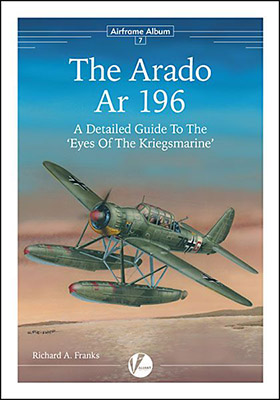
The Arado Ar 196: A Detailed Guide To The 'Eyes Of The Kriegsmarine'
By Chris Banyai-Riepl
Author: Richard A Franks
Publisher: Valiant Wings Publications
ISBN: 978-0-9930908-5-1
Binding: Softcover
Pages: 106
The Arado Ar 196 was the default aircraft for German capital ships during the Second World War, yet because it's not a mainstream fighter or bomber it has not received as much coverage as perhaps it was due. This title from Valiant Wings aims to rectify that issue, and they do it with their usual high quality. Given that we have seen a recent spate of new-tool kits of the Arado, this title is a good one to see.
The book starts out with a general overview of the operational history of the Ar 196 in Germany, Bulgaria, and Rumania, as well as those airframes that were captured by various nations. This is not intended to be the end all, be all history of Arado Ar 196 operations, but rather a high level look, and given what the scope of the book is, that is fine. The rest of the book takes a technical look at the Ar 196, starting with, well, the Technical Description chapter, then an examination of the variant differences, followed by camouflage and markings. The book finishes up with a modeling section.
Looking at each of those sections a bit closer, the technical description chapter is just what you need to detail out your Arado model. This chapter has reproductions of technical documents that cover the cockpit interior, the fuselage and canopy, internal systems, floats, flying surfaces, controls, engine and cowling, armament, and more. Complementing the technical documents are detail photos, resulting in a great blend of information to detail a kit with.
The variant evolution is a useful section as it has an isometric drawing of each Arado Ar 196 variant, with callouts on details. This makes it very easy to see just what needs to be done to a specific variant, if you're starting someplace else. In many cases the differences are internal, such as that for the Ar 196A-4, which has additional fuel tanks in the floats and additional airframe stiffening, otherwise was essentially identical to the Ar 196A-2.
The camouflage and markings section covers the whole life of the Arado Ar 196, from the prototypes to the early production examples to the export variants. This section documents the various differences in camouflages in text and photos, and then backs that up with a series of color profile illustrations. These profile illustrations highlight both German examples and foreign options, with the latter also including post-war civilian usage.
Under the scale model section, there are several builds done in different scales. The first one is an Ar 196V4 converted from the Heller 1/72 Ar 196A. The V4 is unique in that it had a single center float. Following that is an out of the box build of the new Sword 1/72 Ar 196A-3, which is a much more accurate kit than the ancient Heller kit. After 1/72 is done, the next build is the Italeri 1/48 Ar 196, which is simply labeled as an Ar 196A. Finally, the kit section is finished off with the Revell 1/32 Arado Ar 196B, which is a single-float variant.
For those looking for a useful reference on the Arado Ar 196 to use with their next modeling project, this is a perfect title to pick up. For those wanting more detail on the operational history of the type, you'll best look elsewhere, but for the rest of us this book should answer all your questions. My thanks to Valiant Wings for the review copy.
